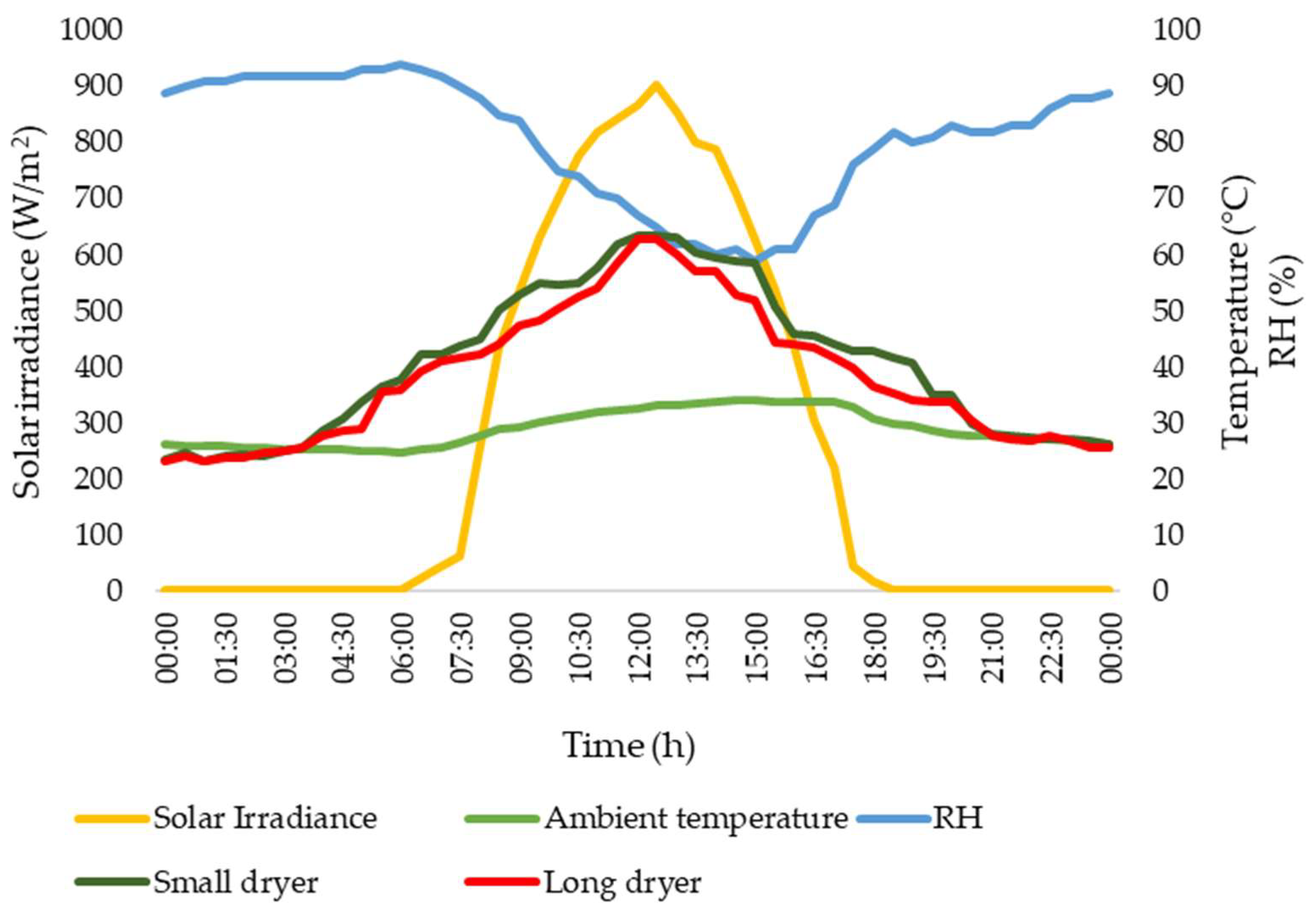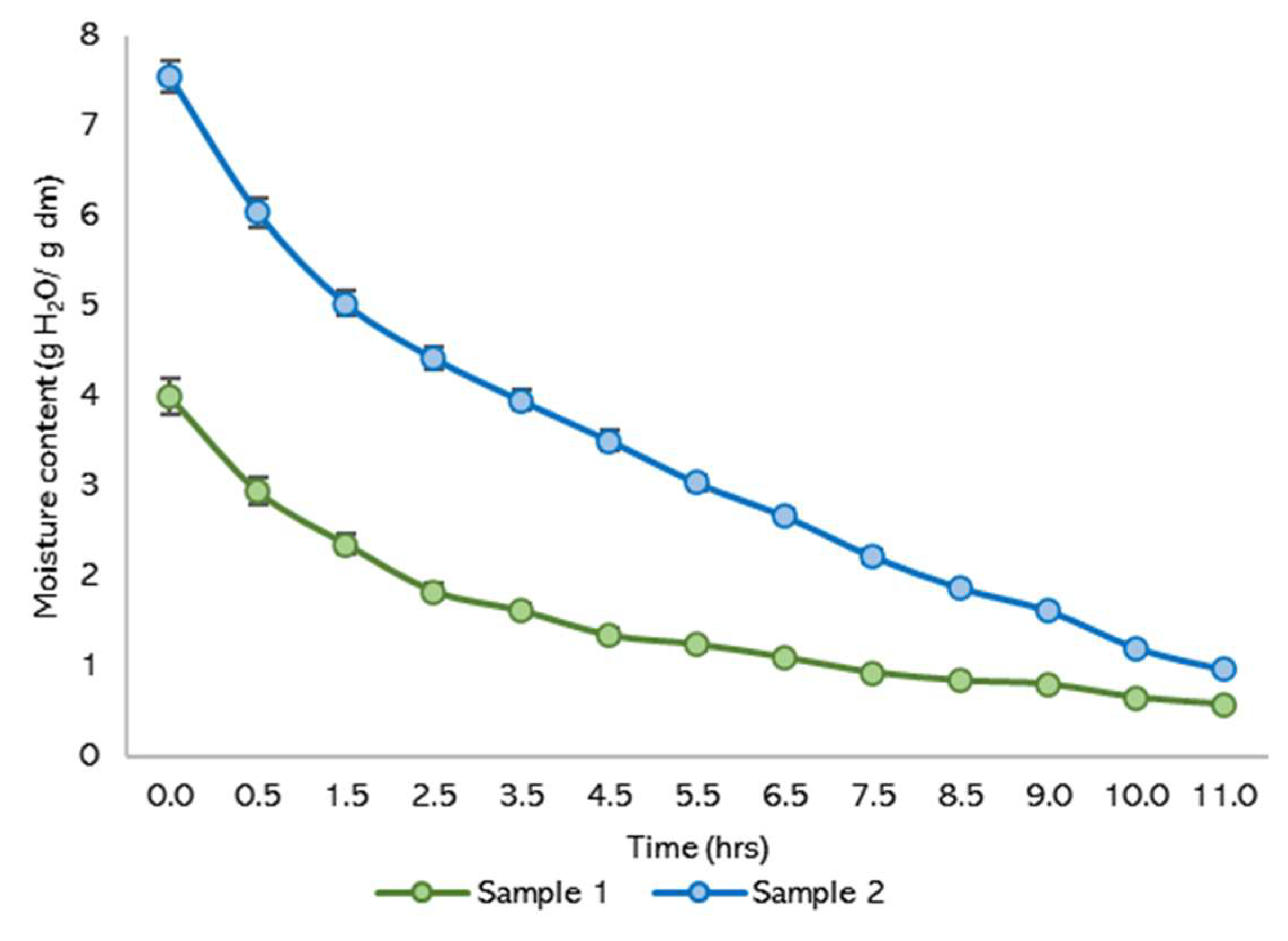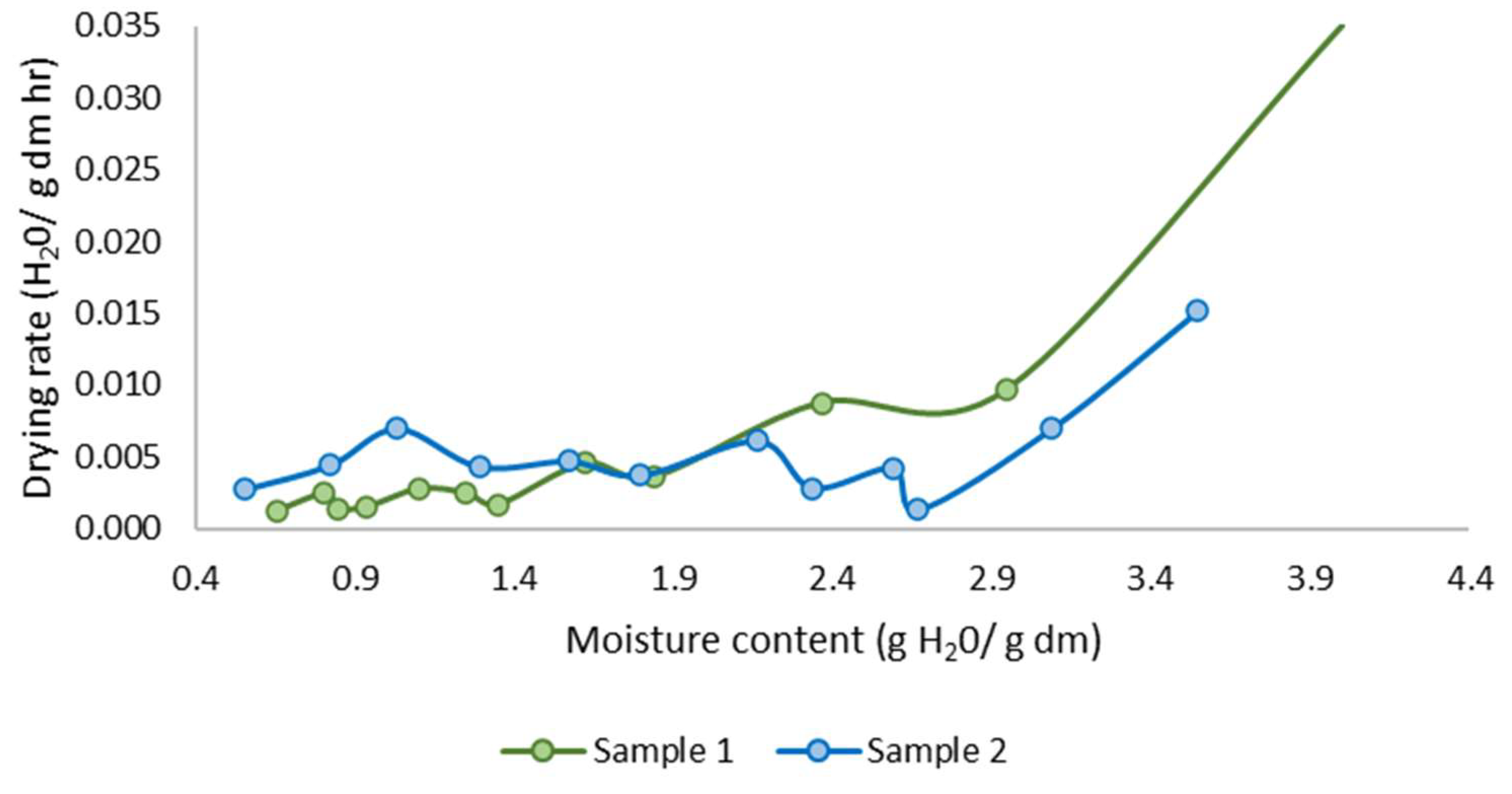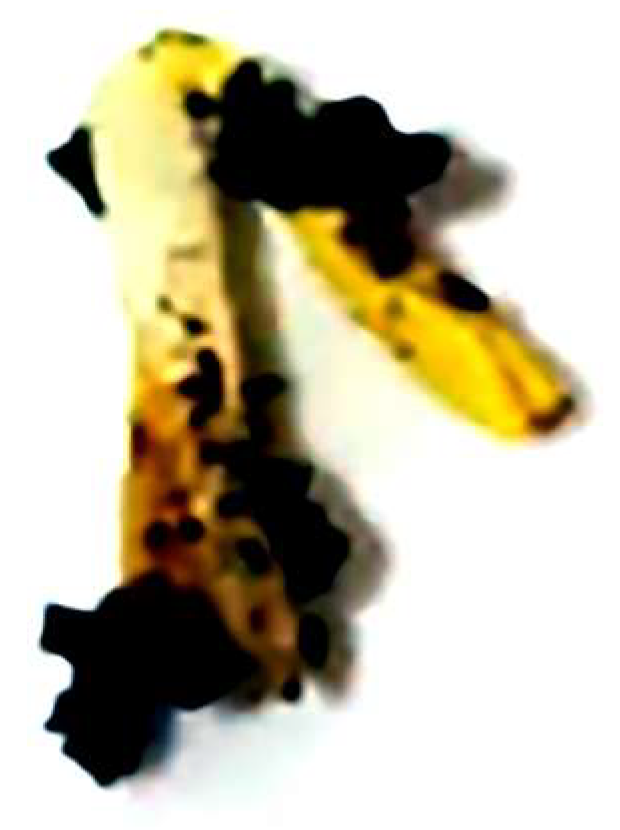Solar-Dried Biofertilizers from Marine Waste: Enhancing the Circular Economy
Abstract
:1. Introduction
2. Materials and Methods
2.1. Solar Drying
2.1.1. Solar Dying Plant
2.1.2. Measuring Instruments
2.1.3. Drying of Fish Waste
2.1.4. Drying Kinetics
2.2. Dried Fish Waste Analysis
2.2.1. Nitrogen Determination
2.2.2. Determination of Sodium, Potassium, and Calcium
2.2.3. Determination of Phosphorus
2.2.4. Determination of Fecal Coliforms
2.2.5. Phytotoxicity
3. Results and Discussion
3.1. Drying of Fish Waste
3.2. Dried Fish Waste Analysis
4. Conclusions
Author Contributions
Funding
Institutional Review Board Statement
Informed Consent Statement
Data Availability Statement
Conflicts of Interest
References
- FAO. Infographics: The High Cost of Food Waste—Global Landscapes Forum. Available online: https://www.globallandscapesforum.org/infographic/infographic-high-cost-of-food-waste/?gclid=Cj0KCQiA8t2eBhDeARIsAAVEga0HqOsvU3big_e6MoxwO-lMWfwmhp5anVTl4Pu98asPmT5yxi6rR8waAncoEALw_wcB (accessed on 31 January 2023).
- UN. Food and Climate Change: Healthy Diets for a Healthier Planet|United Nations. Available online: https://www.un.org/en/climatechange/science/climate-issues/food?gclid=Cj0KCQiA8t2eBhDeARIsAAVEga0QmfDoXjA0UHfwhDryfOTu_KDUfegyjp8DwhY0e4lh2U8R0JaIXZwaAmEeEALw_wcB (accessed on 31 January 2023).
- Poore, J.; Nemecek, T. Reducing food’s environmental impacts through producers and consumers. Science 2018, 360, 987–992. [Google Scholar] [CrossRef] [PubMed]
- World Economic Forum. To Feed the World, We Need to Waste Less Fish. Available online: https://www.weforum.org/agenda/2022/09/feed-world-sustainably-reduce-fish-waste/ (accessed on 7 April 2023).
- Chassot, E.; Antoine, S.; Guillotreau, P.; Lucas, J.; Assan, C.; Marguerite, M.; Bodin, N. Fuel consumption and air emissions in one of the world’s largest commercial fisheries. Environ. Pollut. 2021, 273, 116454. [Google Scholar] [CrossRef] [PubMed]
- Anderson, J.S.; Lall, S.P.; Anderson, D.M.; McNiven, M.A. Availability of amino acids from various fish meals fed to Atlantic salmon (Salmo solar). Aquaculture 1995, 138, 291–301. [Google Scholar] [CrossRef]
- Muscolo, A.; Mauriello, F.; Marra, F.; Calabrò, P.S.; Russo, M.; Ciriminna, R.; Pagliaro, M. AnchoisFert: A New Organic Fertilizer from Fish Processing Waste for Sustainable Agriculture. Glob. Chall. 2022, 6, 2100141. [Google Scholar] [CrossRef] [PubMed]
- FAO. Food Loss and Waste in Fish Value Chains. Available online: https://www.fao.org/flw-in-fish-value-chains/overview/objective/en/ (accessed on 7 April 2023).
- Kristinsson, H.G.; Rasco, B.A. Fish Protein Hydrolysates: Production, Biochemical, and Functional Properties; Taylor & Francis: Abingdon, UK, 2000; Volume 40, pp. 43–81. ISBN 1040869009. [Google Scholar]
- Isibika, A.; Vinnerås, B.; Kibazohi, O.; Zurbrügg, C.; Lalander, C. Co-composting of banana peel and orange peel waste with fish waste to improve conversion by black soldier fly (Hermetia illucens (L.), Diptera: Stratiomyidae) larvae. J. Clean. Prod. 2021, 318, 128570. [Google Scholar] [CrossRef]
- de Carvalho Bonfim, B.; Monteiro, M.L.G.; dos Santos, A.F.G.N.; dos Santos Vilar, J.; Conte-Junior, C.A. Nutritional Improvement and Consumer Perspective of Fish Nuggets with Partial Substitution of Wheat Flour Coating by Fish (Priacanthus arenatus, Cuvier, 1829) Waste Flour. J. Aquat. Food Prod. Technol. 2020, 29, 28–42. [Google Scholar] [CrossRef]
- Czeczuga, B. Carotenoids in fish. XXVIII. Carotenoids in Micropterus salmoides (Lalépéde) Centrarchidae. Hydrobiologia 1981, 78, 45–48. [Google Scholar] [CrossRef]
- Nirmal, N.P.; Santivarangkna, C.; Rajput, M.S.; Benjakul, S. Trends in shrimp processing waste utilization: An industrial prospective. Trends Food Sci. Technol. 2020, 103, 20–35. [Google Scholar] [CrossRef]
- Ruttanapornvareesakul, Y.; Ikeda, M.; Hara, K.; Osako, K.; Kongpun, O.; Nozaki, Y. Effect of shrimp head protein hydrolysates on the state of water and denaturation of fish myofibrils during dehydration. Fish. Sci. 2005, 71, 220–228. [Google Scholar] [CrossRef]
- Aoki, H.; Ahsan, M.N.; Matsuo, K.; Hagiwara, T.; Watabe, S. Partial purification of proteases that are generated by processing of the Northern shrimp Pandalus borealis and which can tenderize beef. Int. J. Food Sci. Technol. 2004, 39, 471–480. [Google Scholar] [CrossRef]
- World Bank. How to Manage the World’s Fertilizers to Avoid a Prolonged Food Crisis. Available online: https://blogs.worldbank.org/voices/how-manage-worlds-fertilizers-avoid-prolonged-food-crisis (accessed on 7 April 2023).
- FAO. Plant Nutrition for Food Security; FAO: Rome, Italy, 2006; ISBN 9251054908. [Google Scholar]
- Sharma, V.; Kaur, J.; Sharma, S. Plant Growth Promoting Rhizobacteria: Potential microbes for sustainable agriculture. Biotecnol. Veg. 2020, 20, 157–166. [Google Scholar] [CrossRef]
- Lanno, M.; Kriipsalu, M.; Shanskiy, M.; Silm, M.; Kisand, A. Distribution of phosphorus forms depends on compost source material. Resources 2021, 10, 102. [Google Scholar] [CrossRef]
- Jung, H.Y.; Kim, J.K. Complete reutilisation of mixed mackerel and brown seaweed wastewater as a high-quality biofertiliser in open-flow lettuce hydroponics. J. Clean. Prod. 2020, 247, 119081. [Google Scholar] [CrossRef]
- Kang, K.H.; Lee, H.; Park, T.; Sim, J.H.; Kim, S.-Y. Biodegradation of High Salinity Fishery Wastes in a 150-L Reactor by Bacillus licheniformis TK3-Y for Reutilization as Liquid Fertilizer. KSBB J. 2020, 35, 288–293. [Google Scholar] [CrossRef]
- Hidayati, P.A.; Mubarak, A.S. Sudarno The optimal n/p ratio of shrimp culture waste liquid fertilizer on growth of Chlorella vulgaris. IOP Conf. Ser. Earth Environ. Sci. 2020, 441, 012090. [Google Scholar] [CrossRef]
- Brasileiro, O.L.; Cavalheiro, J.M.O.; de Sousa Prado, J.P.; dos Anjos, A.G.; Cavalheiri, T.T.B. Determination of the chemical composition and functional properties of shrimp waste protein concentrate and lyophilized flour. Ciência Agrotecnologia 2012, 36, 189–194. [Google Scholar] [CrossRef]
- Zebib, H.; Teame, T.; Aregawi, T.; Meresa, T. Nutritional and sensory acceptability of wheat bread from fish flour. Cogent Food Agric. 2020, 6, 1714831. [Google Scholar] [CrossRef]
- de Oliveira, I.S.; Lourenço, L.d.F.H.; Sousa, C.L.; Joele, M.R.S.P.; do Amaral Ribeiro, S.d.C. Composition of MSM from Brazilian catfish and technological properties of fish flour. Food Control 2015, 50, 38–44. [Google Scholar] [CrossRef]
- Radziemska, M.; Vaverková, M.D.; Adamcová, D.; Brtnický, M.; Mazur, Z. Valorization of Fish Waste Compost as a Fertilizer for Agricultural Use. Waste Biomass Valorization 2019, 10, 2537–2545. [Google Scholar] [CrossRef]
- Shaji, H.; Chandran, V.; Mathew, L. Chapter 13—Organic fertilizers as a route to controlled release of nutrients. In Controlled Release Fertilizers for Sustainable Agriculture; Lewu, F.B., Volova, T., Thomas, S., Rakhimol, K.R., Eds.; Academic Press: Cambridge, MA, USA, 2021; pp. 231–245. ISBN 978-0-12-819555-0. [Google Scholar]
- Illera-Vives, M.; Seoane Labandeira, S.; Brito, L.M.; López-Fabal, A.; López-Mosquera, M.E. Evaluation of compost from seaweed and fish waste as a fertilizer for horticultural use. Sci. Hortic. 2015, 186, 101–107. [Google Scholar] [CrossRef]
- Marzuki, S.U.; Pranoto, Y.; Khumsap, T.; Nguyen, L.T. Effect of blanching pretreatment and microwave-vacuum drying on drying kinetics and physicochemical properties of purple-fleshed sweet potato. J. Food Sci. Technol. 2021, 58, 2884–2895. [Google Scholar] [CrossRef]
- Saengrayap, R.; Tansakul, A.; Mittal, G.S. Effect of far-infrared radiation assisted microwave-vacuum drying on drying characteristics and quality of red chilli. J. Food Sci. Technol. 2015, 52, 2610–2621. [Google Scholar] [CrossRef]
- Duan, Z.; Zhang, M.; Hu, Q.; Sun, J. Characteristics of Microwave Drying of Bighead Carp. Dry. Technol. 2005, 23, 637–643. [Google Scholar] [CrossRef]
- Reineccius, G.A. The Spray Drying of Food Flavors. Dry. Technol. 2004, 22, 1289–1324. [Google Scholar] [CrossRef]
- Bajgai, T.R.; Hashinaga, F. High Electric Field Drying of Japanese Radish. Dry. Technol. 2001, 19, 2291–2302. [Google Scholar] [CrossRef]
- Batista, J.T.S.; da Silva Araújo Matias, C.; da Silva Martins, L.H.; Cardoso, D.N.P.; Joele, MRSP; de Fátima Henriques Lourenço, L. Effect of convection drying and lyophilization of fish myofibrillar proteins on the technological properties of biodegradable films. Dry. Technol. 2022, 40, 1673–1687. [Google Scholar] [CrossRef]
- Mandal, M.; Roy, A.; Das, S.; Rakwal, R.; Agrawal, G.K.; Singh, P.; Awasthi, A.; Sarkar, A. Food waste-based bio-fertilizers production by bio-based fermenters and their potential impact on the environment. Chemosphere 2024, 353, 141539. [Google Scholar] [CrossRef] [PubMed]
- Martínez-Moreno, M.M.; Buitrago, E.M.; Yñiguez, R.; Puig-Cabrera, M. Circular economy and agriculture: Mapping circular practices, drivers, and barriers for traditional table-olive groves. Sustain. Prod. Consum. 2024, 46, 430–441. [Google Scholar] [CrossRef]
- NMX-AA-180-SCFI-2018; Que establece los métodos y procedimientos para el tratamiento aerobio de la fracción orgánica de los residuos sólidos urbanos y de manejo especial, así como la información comercial y de sus parámetros de calidad de los productos finales. Dirección General de Normas Mexicanas: Mexico City, Mexico, 2018; p. 52.
- Licon, C. Proximate and Other Chemical Analyses☆. In Encyclopedia of Dairy Sciences, 3rd ed.; McSweeney, P.L.H., McNamara, J.P., Eds.; Academic Press: Oxford, UK, 2022; pp. 521–529. ISBN 978-0-12-818767-8. [Google Scholar]
- Knowles, V.; Plaxton, W. Quantification of Total and Soluble Inorganic Phosphate. Bio-Protocol 2013, 3, e890. [Google Scholar] [CrossRef]
- DOF—Diario Oficial de la Federación NOM-004-SEMARNAT-2002. Available online: https://dof.gob.mx/nota_detalle.php?codigo=691939&fecha=15/08/2003#gsc.tab=0 (accessed on 17 July 2024).
- Gerber, M.D.; Arsand, D.R.; Lucia, T.; Correa, É.K. Phytotoxicity Evaluation of Wastewater from Rice Parboiling. Bull. Environ. Contam. Toxicol. 2018, 101, 678–683. [Google Scholar] [CrossRef] [PubMed]
- Kong, Y.; Wang, G.; Chen, W.; Yang, Y.; Ma, R.; Li, D.; Shen, Y.; Li, G.; Yuan, J. Phytotoxicity of farm livestock manures in facultative heap composting using the seed germination index as indicator. Ecotoxicol. Environ. Saf. 2022, 247, 114251. [Google Scholar] [CrossRef] [PubMed]
- Blas, C.; Mateos, G.; García, P. Tablas FEDNA de Composición y Valor Nutritivo de Alimentos para la Fabricación de Piensos Compuestos; Blas, C., García-Rebollar, P., Gorrachategui, M., Mateos, G., Eds.; Fundación Española para el Desarrollo de la Nutrición Animal: Madrid, Spain, 2019; Volume 1, ISBN 978-8409156887. [Google Scholar]
- Illera-Vives, M.; Seoane Labandeira, S.; Iglesias Loureiro, L.; López-Mosquera, M.E. Agronomic assessment of a compost consisting of seaweed and fish waste as an organic fertilizer for organic potato crops. J. Appl. Phycol. 2017, 29, 1663–1671. [Google Scholar] [CrossRef]
- Ahuja, I.; Dauksas, E.; Remme, J.F.; Richardsen, R.; Løes, A.-K. Fish and fish waste-based fertilizers in organic farming—With status in Norway: A review. Waste Manag. 2020, 115, 95–112. [Google Scholar] [CrossRef] [PubMed]
- Ossai, I.C.; Ahmed, A.; Hassan, A.; Hamid, F.S. Remediation of soil and water contaminated with petroleum hydrocarbon: A review. Environ. Technol. Innov. 2020, 17, 100526. [Google Scholar] [CrossRef]












| Variable | Description | Model | Maximum Error |
|---|---|---|---|
| Global radiation | Pyranometer (brand LI-COR) | LI-200R (Lincoln, NE, USA) | Azimut: <±1% on 360° to 45° elevation |
| Relative humidity | NRG Systems | RH-5X (Hinesburg, VT, USA) | ±3% |
| Ambient temperature | NRG Systems | 110S (Hinesburg, VT, USA) | ±1.1 °C |
| Wind direction | NRG Systems | Series 200P (Hinesburg, VT, USA) | ±3° |
| Anemometer | Wind sensor | P2546C-OPR (Roskilde Denmark) | ±0.3 m/s |
| Component | % Weight d.b. (w/w) |
|---|---|
| Organic nitrogen equivalent | 7.99 |
| Phosphorus in P2O5 equivalent | 6.67 |
| Potassium in K2O equivalent | 0.5 |
| Calcium in CaO equivalent | 6.37 |
| Sodium | 0.4 |
Disclaimer/Publisher’s Note: The statements, opinions and data contained in all publications are solely those of the individual author(s) and contributor(s) and not of MDPI and/or the editor(s). MDPI and/or the editor(s) disclaim responsibility for any injury to people or property resulting from any ideas, methods, instructions or products referred to in the content. |
© 2024 by the authors. Licensee MDPI, Basel, Switzerland. This article is an open access article distributed under the terms and conditions of the Creative Commons Attribution (CC BY) license (https://creativecommons.org/licenses/by/4.0/).
Share and Cite
Castillo-Téllez, B.; Castillo Téllez, M.; Campo, M.F.M.d.; González, E.O.Z.; Domínguez Niño, A.; Mejía-Pérez, G.A. Solar-Dried Biofertilizers from Marine Waste: Enhancing the Circular Economy. Sustainability 2024, 16, 6593. https://doi.org/10.3390/su16156593
Castillo-Téllez B, Castillo Téllez M, Campo MFMd, González EOZ, Domínguez Niño A, Mejía-Pérez GA. Solar-Dried Biofertilizers from Marine Waste: Enhancing the Circular Economy. Sustainability. 2024; 16(15):6593. https://doi.org/10.3390/su16156593
Chicago/Turabian StyleCastillo-Téllez, Beatriz, Margarita Castillo Téllez, Martha Fabiola Martín del Campo, Edgar Oswaldo Zamora González, Alfredo Domínguez Niño, and Gerardo Alberto Mejía-Pérez. 2024. "Solar-Dried Biofertilizers from Marine Waste: Enhancing the Circular Economy" Sustainability 16, no. 15: 6593. https://doi.org/10.3390/su16156593







